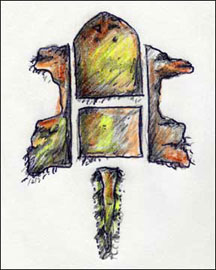
All you braintanners know the situation: You have successfully tanned all those neat pelts and skins and now you wonder what the heck to do with them.
Well, I had two raccoon skins in my closet for a while and did not want to make them into Davy Crocket coon skin hats. First of all, it is almost never cold enough, where I live, to be able to wear such a piece of clothing and, on the other hand, I already have half a dozen fur hats lying around. So, I decided to fashion one of the raccoon skins into a bag. I like the design of the bag because it preserves and shows all the features typical of the animal and makes it easy to identify. Here is how to make it.

Drawing 1 shows the flesh side of the skin. It is already cut into the pieces to be used. The two square-like pieces and the tail will be used for the bag, while the leg and belly parts get discarded. To cut the skin, I recommend a sharp knife as opposed to scissors. A knife will cut the skin, but leave the fur undamaged.
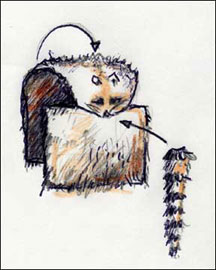
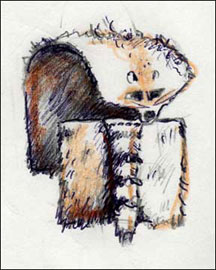
Drawings 2 and 3 show how the face of the animal will be brought
to the front in order to be the flap. The tail simply gets sewn
to the front part of the bag.
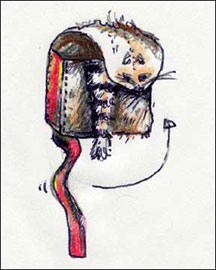
The last drawing shows how a border of cloth or leather gets
sewn all the way around to connect the two pieces to form the
bag. You could simply sew the two pieces together without the
cloth strip, but this only gives you a very small pouch. The cloth
insert strip increases the size of the bag and also adds a nice
color contrast. The last thing to do is to attach the carrying
strap to the cloth insert and your bag is finished.
My raccoon bag is about 9 inches by 9 inches square and 1 1/2
inches deep. The little black beads sewn to the cloth are seeds
that I collected from an unidentified tree-like shrub that is
fairly common where I live. The bag got me a lot of attention.
People are usually either amused, surprised, or shocked when they
hear of its origin. It is definitely "cooler" than something
you can buy at The Gap. The only sweatshop labor involved being
your own.
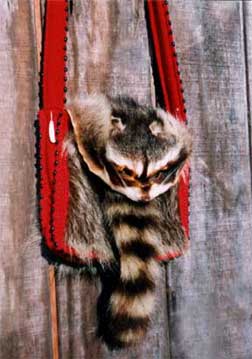
E-mail your comments to "Markus Klek" at markusklek@hotmail.com
We hope the information on the PrimitiveWays website is both instructional and enjoyable. Understand that no warranty or guarantee is included. We expect adults to act responsibly and children to be supervised by a responsible adult. If you use the information on this site to create your own projects or if you try techniques described on PrimitiveWays, behave in accordance with applicable laws, and think about the sustainability of natural resources. Using tools or techniques described on PrimitiveWays can be dangerous with exposure to heavy, sharp or pointed objects, fire, stone tools and hazards present in outdoor settings. Without proper care and caution, or if done incorrectly, there is a risk of property damage, personal injury or even death. So, be advised: Anyone using any information provided on the PrimitiveWays website assumes responsibility for using proper care and caution to protect property, the life, health and safety of himself or herself and all others. He or she expressly assumes all risk of harm or damage to all persons or property proximately caused by the use of this information.
© PrimitiveWays 2013